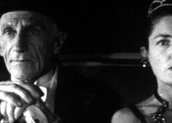


The Hungry Miles (1955)
Synopsis
The Hungry Miles is a documentary made by the Waterside Workers’ Federation Film Unit. It documents industrial relations on the waterfront since the 1930s and includes dramatised scenes of working conditions during the Depression. It also recounts the background to the Federal Government’s 1954 amendments to the Stevedoring Industry Act, which proposed to give shipowners the right to directly recruit wharf labour and bypass the union; shows workers demonstrating; contrasts the gap between industry and workers in the division of profits; and evokes the spirit of the Eureka Stockade in portraying the solidarity amongst waterside workers. It includes voice-over narration by Leonard Teale and employs an orchestral score.
Curator’s notes
WWF Secretary Jim Healy (who appears in The Hungry Miles) approached the film unit to document the union’s industrial conflicts. Like their earlier film, Pensions for Veterans (1953), filmmakers Jock Levy, Keith Gow and Norma Disher based the script on historical events and the recollections of wharfie veterans.
The Hungry Miles covers more historical ground than the unit’s earlier works and they regarded it as one of their most significant accomplishments. The film emphasises solidarity and unity over individualism in a classic documentary style that builds an emotive argument through imagery and symbolism. The authoritative narrative voice adds to the film’s persuasiveness and the orchestral score shifts in register and mood with each thematic segment, culminating in the final celebratory flying of the Eureka flag.
The first section positions waterside labour as the lifeblood of the country’s wealth. The film then surveys the 'industrial storm clouds’ hovering over the waterfront. Newspaper clippings depict wharfies as lazy and strike prone. The filmmakers provide background to proposed legislative amendments that would prevent the union recruiting labour on the waterfront and led to wharfies stopping work on the docks (see clip one). A re-creation of the 1930s depicts the harsh working conditions that the unions had fought so hard to improve (clip two).
The film builds up sympathy for the workers and their hard-fought battles, assisted by Teale’s emotive narration. Shipping industry and government officials are argued to be working against the interests of the workers and keeping all the profits for themselves. The affluent classes are presented as greedy and decadent – 'Luxury belongs to those who never loved a bag of wheat, sweated in a sugar boat or stowed a bale of wool’. In an extravagant banquet scene, the wealthy gorge themselves by candlelight and drink champagne (see clip three).
The Waterside Workers’ Federation Film Unit formed in 1953 and, over the next five years, made films about the waterside workers, their battles and history. The unit also made films for other unions including The Bones of Building (1956) for the Building Workers’ Industrial Union and Hewers of Coal (1957) for the Miners’ Federation.
Fighting Films: A History of the WWF Film Unit (2003, Pluto Press) was written by academic Lisa Milner based on her PhD research into the WWF Film Unit. The book was jointly funded by the Maritime Union of Australia, the Construction Forestry Mining Energy Union (Mining and Construction Divisions) and the Australian Manufacturing Workers’ Union. To coincide with the publication, the MUA released a three-DVD compilation featuring 13 of the WWF Unit’s films as well as John Hughes’s documentary Film-work (1981).
The Hungry Miles premiered to 5,000 waterside workers at the Leichhardt Stadium in Sydney in February 1955 and screened at the Sydney Film Festival in the same year. The film also travelled the international film society circuit.
- Overview
- Curator’s notes
- Video 3 clips
- Principal credits
- Find a copy
- Make a comment
- Map
- Add your review



